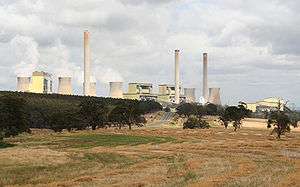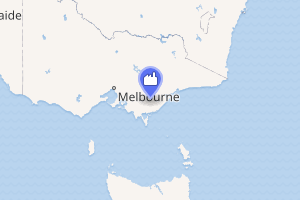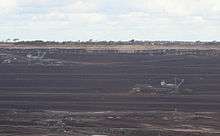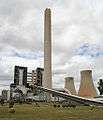Loy Yang Power Station
The Loy Yang Power Station is a brown coal-fired thermal power station located on the outskirts of the city of Traralgon, in south-eastern Victoria, Australia. It consists of two sections, known as Loy Yang A and Loy Yang B. Both Loy Yang A and B are supplied by the Loy Yang brown coal mine. The Loy Yang power stations are located in the brown coal rich Latrobe Valley, along with the Yallourn power station.
| Loy Yang Power Station | |
|---|---|
 Loy Yang B (left), Loy Yang A (centre), coal bunkers from open cut mine (right). | |

| |
| Country | Australia |
| Location | Traralgon, Victoria |
| Coordinates | 38°15′16″S 146°34′37″E |
| Status | Operational |
| Commission date | 1985 |
| Owner(s) |
|
| Thermal power station | |
| Primary fuel | Brown coal |
| Power generation | |
| Units operational |
|
| Make and model | BBC Kraftwerk Union Hitachi |
| Nameplate capacity | 3,280 MW (4,400,000 hp) |
| External links | |
| Commons | Related media on Commons |
Loy Yang A has four generating units with a combined capacity of 2,210 MW (2,960,000 hp). In June 2012 AGL Energy acquired Loy Yang A and the Loy Yang coal mine.[1]
Loy Yang B has two units with a capacity of 1,070 MW (1,430,000 hp) and is Victoria's newest and most efficient brown coal-fired power station. It can generate approximately 17% of Victoria's power needs. Until November 2017, it was jointly owned by Engie (formerly GDF Suez Australia), which held a 70% stake, and Mitsui & Co Ltd with 30%. Loy Yang B employs up to 152 full-time staff and another 40 contractors. In November 2017, Engie sold Loy Yang B to Chow Tai Fook Enterprises for a reported AU$1.2 billion.
If Loy Yang A and Loy Yang B are counted together they are the largest power station in Australia, generating 3,280 MW (4,400,000 hp) of power (however, if counted separately, the 2,880 MW Eraring power station is the largest). Loy Yang A & B are base load power stations, and together produce 50% of Victoria's electricity requirements.
History

Loy Yang was originally constructed through the 1980s by International Combustion Australia Ltd, who was contracted by the government owned State Electricity Commission of Victoria (SECV). It consists of two separate units, Loy Yang A and Loy Yang B. Constructed in stages, it was originally planned that the Loy Yang complex would consist of eight generating units, of 525 megawatts (704,000 hp) each upon completion. The privatization of the SECV resulted in only six generating units being completed, four in Loy Yang A and two in Loy Yang B. The chimneys were constructed by Thiess Contractors.[2]
Loy Yang A's four units were completed between 1984 and 1988.[3] Loy Yang A consists of three units with Kraftwerk Union alternators (units 1, 3 and 4) and one unit by Brown Boveri Corp (unit 2) that was supposed to be the second unit at the gas-fired Newport power station. Later during the 2000s the turbine/generator couplings were upgraded on the 3 Kraftwerk Union units to allow an increase in MCR to 560MW.
Loy Yang B's two units entered service in 1993 and 1996.[4] The two units have Hitachi turbo generators. All six Loy Yang boilers are of the forced circulation tower type and are made by International Combustion Australia Ltd. Steam is supplied at a pressure of 16 MPa and a temperature of 540 degrees Celsius.
The Loy Yang complex was privatised in 1995, as were most of the assets of the SECV. Prior to the Victorian Government's privatisations from the mid-1990s, a 49% stake of Loy Yang B was sold to Mission Energy. Later Edison Mission bought the complete plant, and later again sold it to the joint venture International Power Mitsui.
In 1995, Loy Yang B was the world's first coal-fired power station to gain quality accreditation to ISO 9001 and the first Australian power station to gain environmental accreditation to ISO 14001.
Four giant bucket-wheel excavators, called dredgers, operate 24 hours a day in the Loy Yang open cut mine, mostly feeding coal directly to the boilers via conveyor belt, 18 hours of reserve supply is held in a 70,000 tonnes (69,000 long tons) coal bunker. Each year approximately 30 million tonnes (30×106 long tons) of coal are extracted from the open pit. The open cut coal mine pit is about 200 metres (660 ft) deep, 3 kilometres (1.9 mi) and 2 kilometres (1.2 mi) wide at its widest. It is estimated that at current rates of extraction there are sufficient deposits of coal in the entire Latrobe Valley region to last 1300 years.
Carbon Monitoring for Action estimates this power station emits 14.4 million tonnes (14.2×106 long tons) of greenhouse gases each year as a result of burning coal.[5] On 3 September 2007 the Loy Yang complex was the target of climate change activists. The activists locked themselves to conveyor belts and reduced power production for several hours before being cut free. Four people were arrested.[6]
In March 2010 it was announced that the operators of Loy Yang A (Loy Yang Power) signed a contract with Alcoa World Alumina and Chemicals Australia for the supply of electricity to power aluminium smelters at Portland and Point Henry until 2036.[7] The Point Henry Smelter ceased operation in 2014 and is now closed. In June 2012 AGL Energy acquired Loy Yang A and the Loy Yang coal mine.[8]
In November 2017, Engie sold Loy Yang B to Chow Tai Fook Enterprises for a reported [AU]$1.2 billion,[9][10] despite some reported that it was acquired by Chow Tai Fook Enterprises' subsidiary Alinta Energy instead.[11]
Engineering heritage award
The power station received an Engineering Heritage Marker from Engineers Australia as part of its Engineering Heritage Recognition Program.[12]
Gallery
 Two large dredges working coal face, and smaller unit on the mine floor.
Two large dredges working coal face, and smaller unit on the mine floor. Loy Yang A.
Loy Yang A. Loy Yang B.
Loy Yang B.
References
- Loy Yang A supplies approximately 30% of Victoria’s power requirements.
- "Thiess: a proud history". Australian Mining Review. 29 March 2019. Retrieved 3 January 2019.
- "AGL Loy Yang | AGL". www.agl.com.au. Retrieved 6 July 2016.
- "Loy Yang B Power Station | ENGIE". www.gdfsuezau.com. Retrieved 6 July 2016.
- "Loy Yang A". Carbon Monitoring for Action. Retrieved 18 January 2014.
- "APEC Climate Action Shuts Down Victorian Coal Power Station A". Indymedia. 3 September 2007. Archived from the original on 21 September 2007. Retrieved 5 September 2007.
- "Alcoa deal locks in jobs - and emissions". The Sydney Morning Herald. 2 March 2010. Retrieved 18 January 2014.
- AGL Loy Yang supplies approximately 30% of Victoria’s power requirements.
- "Loy Yang B Power Station Acquisition" (Press release). Alinta Energy. 24 November 2017. Retrieved 9 November 2018.
Alinta Energy's owner, Chow Tai Fook Enterprises (CTFE), has today entered into a conditional binding agreement to acquire the Loy Yang B power station.
- Ogden, Melinda (23 November 2017). "Coal-fired Loy Yang B power station sold to Alinta Energy's owners Chow Tai Fook Enterprises". Australian Broadcasting Corporation. Retrieved 9 November 2018.
- Latimer, Cole (23 November 2017). "La Trobe Valley's Loy Yang B coal-fired power station sold to Chinese-owned company". The Age. Retrieved 9 November 2018.
- "Loy Yang Power Station - 1984-". Engineers Australia. Retrieved 3 May 2020.